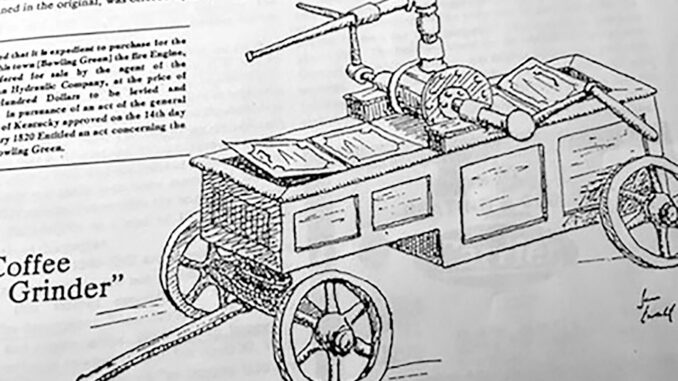
Words are fascinating! Oral and written history has introduced us to a wealth of words that sprang out of individual actions or events and became permanent members of our routine vocabulary. Bandwagon is an example. America’s first great showman, Phineas T. Barnum, created the word to encourage people to join his celebration. From the 17th century books of rules regulating friction over the game of whist came the words According to Hoyle. There is also the English word, bigwig. From the world of cockfighting using metal spurs entered the word, well-heeled into our regular use. From John Milton’s coining the word pandemonium in his writings, in the 14th century appeared the horticulture words, nip it in the bud. Others include eager beaver, wet behind the ears… seems the list can go on forever as the reader reviews his own fascinating words.
A commonly-used expression today appeared the first time in print in 1973 in the Boston (Mass.) News. First Responders has had more noticeable use since the September 11th event and the COVID crisis. The word is usually used to refer to medical staff, police efforts and the firefighters. Not to demean the first two, but fire responders are the focus of this month’s article.
Beginning in the early Bowling Green settlement in the 1790s, the early reactors to a fire were simply nearby individuals using a bucket brigade or whatever to stifle the flames and save the structure. In early times, there were no firefighters organized to carry out the task. If there was to be a field burn to prepare the land for growing crops, the neighbors would space themselves around the field to prevent spreading the flames too far. It was not until further community growth that the city leaders addressed the need of such paid personnel.
Several years ago, a gentleman named Edward B. McCurley, writing an article for publication in the Kentucky Professional of Firefighters, did an extensive research of the minutes of local government meetings. The inquiry also included examining news articles relating to the history of fire protection in the city. This also included acts by the General Assembly of Kentucky regarding the city’s efforts. His sixteen page History of a Fire Department I find so worthy, my best efforts would be to share the highlights of his research to parade the care our city has made to keep citizens safe and informed.
It was in 1820 that the city officials first expressed concern about government-managed fire protection. Henry Shanks was selected to be in charge of fire equipment and to recruit a fire company reporting regularly to the justices. It was not until 1832 that the first fire pump was purchased from the American Hydraulic Company, costing $318, and in the same year the first fire house was established. (Note Mr. McCurley’s picture suggesting this possible equipment.) A need for a second engine was purchased for the growing city in 1839.
As the city expanded its city limits, a second engine house was secured in 1857. As Mr. McCurley’s details continued, he conveniently included pictures mostly secured from Kentucky Museum’s extensive Special Collections resources. Some are shown in this column. On November 22, 1873 a major change in fire protection was made. The common council proposed “the city furnish all the necessary equipment for an organized fire company, working without engines and by the force of water from fire plugs located throughout the city” (page 41 of History of Fire Department).
Several capable citizens were appointed to lead the constantly-growing city fire department. Their names and pictures are proudly displayed in the local department on Fairview Avenue. On September 1, 1898 the city’s first paid department was appointed. James A. Wilkerson was made Fire Chief, who as city engineer was called “Lucky Jim” because of his narrow escape while surviving as a voluntary fireman during the Potter Opera House fire. John Moltenberry and David W. Harrison were appointed firemen working with volunteers. The fire station at that time was located on the east side of State Street near the Park City Hotel. Instead of pulling their equipment by hand, the department obtained the first hose and chemical engine that fall and in 1901 a hook and ladder. Mayor Gilson E. Townsend was eager to have first-class equipment for this first-class city.
The most notable Fire Chief during the early years was John Moltenberry. He was appointed Chief April 1, 1904 after serving two years as a fireman and three years as a Captain. He served as Chief until the end of 1938 except for the years 1909-1911 when politics got involved and department transformation occurred. During these early years two major fires shook the city: the Potter Opera House (a building somewhat modernized but still standing on the corner of College and Main) and the McCormack Building at the corner of State Street and 10th Street where United Furniture exists today. The McCormack was the major location of important city agencies and became the worst fire in the city’s history since the destruction with fire to the north side of the square by the retreating Confederate troops.
“Horses were not to last long in the new fire station” (p 48 HOBGFD). The city council became interested in obtaining an “auto truck” in 1913 to eliminate the expense of keeping so many horses. An Ahrens-Fox fire engine arrived April 17, 1914. Horses were totally eliminated by 1918 when a NO. 2 Kankakee and a NO. 3 Kankakee were obtained. (The modern station at that time was located on 10th Street near College Street and can be seen by pictures from the Camilla Gerard Collection, a wealth of historical items contributed to the Kentucky Library at Western Kentucky University.)
In order to continue providing fire services to Bowling Green citizens, the fire department expanded from one station to three in 1955 and since then has increased to seven today with 128 firefighters. Another significant change occurred in 1977 when women entered the fire service with roles as dispatchers, and African Americans were hired as fireman.
Bowling Green is aware of the constant need for protection from unwelcomed fires, “but things have changed in the 147 years (201 years in 2021) since the purchase of its first fire engine. Instead of a handful of volunteers struggling with a single hand-operated pump to protect the lives and property of a few hundred, 79 full-time, professional firefighters with eight pieces of firefighting apparatus and some of the most modern equipment available today, seek to protect the lives and property of a growing city”. (p 52)
Thank you, Mr. Edward B. McCurley, for your excellent and professional look at the history of the Bowling Green Fire Department.
-by Mary Alice Oliver
About the Author: Mary Alice Oliver is a Bowling Green native who is a 1950 graduate of Bowling Green High School. She retired from Warren County Schools after 40 years in education. Visiting familiar sites, researching historical records and sharing memories with friends are her passions.






